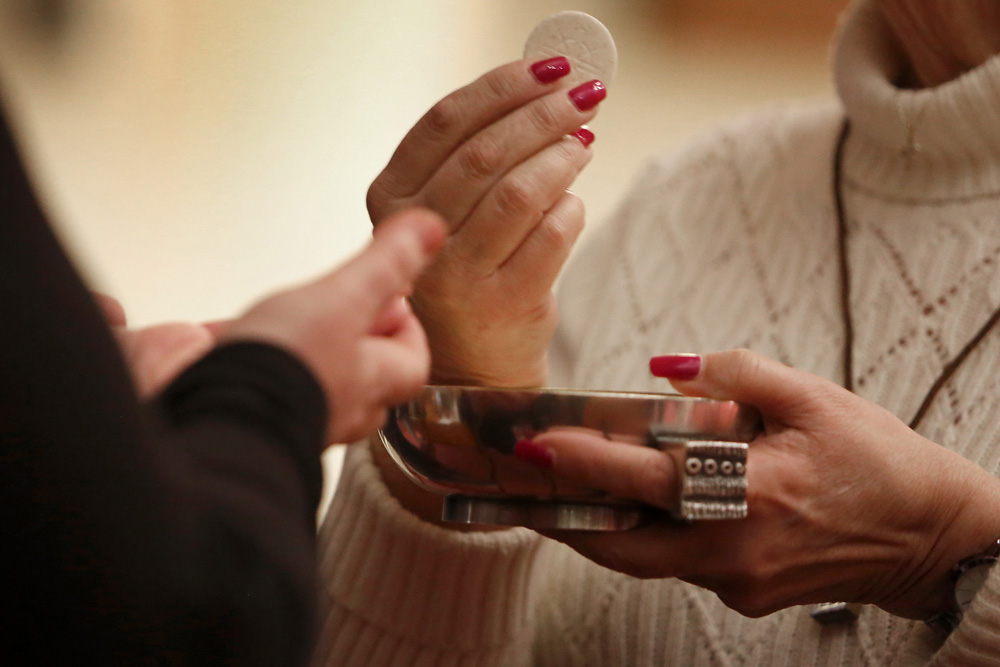
A eucharistic minister distributes Communion in this CNS file photo (CNS/Karen Callaway, Chicago Catholic)
First off, I'm inclined to give the pollsters a break, at least in the case where they were asking Catholics about the Eucharist and the real presence. This isn't quite as easy as "Do you like Donald or Hillary?"
Pollsters aren't looking for paragraphs.
When Pew Research asked the questions (providing multiple choice answers), the researchers concluded that nearly 70 percent of Catholics believed the bread and wine were symbols of the body and blood of Christ and that only about 30 percent believed that during the Mass "the bread and wine actually become the body and blood of Jesus."
Well, the devil, ahem, is once again in the details. What do you mean by symbol? What do you mean by "actually"? Were the wording and the answer choices weighted in a way that determined the outcome? Are Catholics so disbelieving that we have to get our catechetical hair on fire and go back to the drawing board?
Our national correspondent, Heidi Schlumpf, relentlessly inquisitive and perpetually dissatisfied with pat answers (and polls), got to it and found out — as you'll learn here — that the reality is far more complex and genuinely edifying than either the bare-knuckle prose of a poll summary or the breathless indignation of church elders.
Los Angeles Auxiliary Bishop Robert Barron, the hip hierarch of evangelizers, was spitting mad. "It's hard to describe how angry I feel," he tweeted. "This should be a wake-up call to all of us in the Church." He was mad at himself, at other bishops, at priests, "at anybody" involved in passing on the faith. Whew. Shall we expect soon the marketing of a new Barron video on the Eucharist?
I recommend reading Schlumpf's interviews with considered and less hysterical thinkers and teachers of the faith. You'll find their words rich and textured, their understanding of Eucharist steeped in history and reality, and their optimism that a significant number of Catholics are quite reverential and considerate of the countless shades of understanding of the subject.
I would also recommend reading the letters readers have written responding to the issue — so many of them we've had to divide them into two batches here and here — thoughtful letters that are consoling, smart, challenging and moving.
I happened to be reading Franciscan Fr. Richard Rohr's book, The Universal Christ: How a Forgotten Reality Can Change Everything We See, Hope For, and Believe, when the poll came out. The book's section on the Real Presence would have been valuable to pollsters and the polled. Rohr noted that his education makes him aware "of the distinctions and clarifications about what Jesus's words are supposed to mean: he is giving us his full Jesus-Christ self — that wonderful symbiosis of divinity and humanity." A little later he writes, "Presence is a unique capacity that includes body, heart, mind, and whatever we mean by 'soul.' Love affairs never happen just in the mind."
The need for deepening our understanding of the mysteries of faith and for sound teaching is lifelong, but I would wager heavily that the millions who regularly approach the Eucharist have an innate and compelling understanding of real presence, Pew polls notwithstanding.
I am pleased to announce that the work of Dawn Araujo-Hawkins, who has written for Global Sisters Report for the past five years, was recognized earlier this year by the American Academy of Religion. The three stories she submitted: "Seeking Refuge: As resettlement agency closes, other doors open," "First black sisters pioneered black spirituality in Catholic Church," and "Michael Brown's death still galvanizes anti-racism efforts in Ferguson" represent stories that "often aren't provided the kind of treatment they deserve," said the jurors. They won second place in the category of best in-depth newswriting on religion.
Jurors noted that the series "highlights how people in adverse circumstances can often discover the best in themselves and in others by summoning their religious ideals."
Araujo-Hawkins, who also won first place in the AAR awards in 2016, recently took a new position as news editor with The Christian Century magazine.
Joshua J. McElwee, NCR Vatican correspondent, won a third place this year in the same category with five articles published in 2018, dealing with prosecution of bishops, the resignation of Washington Cardinal Donald Wuerl, procedures for investigating bishops and critiques by three former members of the papal commission calling for reevaluating the group.

Sarah Salvadore (NCR/Toni-Ann Ortiz)
The judges termed the stories "really strong reporting on what is considered one of the biggest religion stories of 2018 by someone who understands the Catholic church well. … This is a great collection of pertinent information whereby if you weren't well read on the topic you would feel better informed after reading it all."
I am also delighted to introduce NCR's newest Bertelsen intern, Sarah Salvadore, who earned a master's in journalism from the Columbia University Graduate School of Journalism in 2016 and a master's in religion from Seton Hall University this year, specializing in Jewish-Christian studies.
She earlier earned a bachelor's degree in economics and finance from Hislop College, University of Nagpur, Nagpur, India, and a post-graduate diploma in journalism from the Institute of Media Studies and Information Technology in New Delhi. She worked in several capacities as reporter and editor for the Times of India from 2005-2014.
She has done considerable research, reporting and writing on global immigration issues, with a focus on women and immigration. She will be working primarily from New Jersey.
[Tom Roberts is executive editor of National Catholic Reporter. His email is troberts@ncronline.org.]
Advertisement








